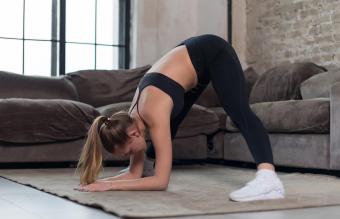
The yoga squat is a pose that requires flexibility of the ankles, hips, and chest, along with strength in your shoulders, thighs, and back. With the right instructions and proper warmup, you can successfully achieve the squat on your own.
How to Do a Yoga Squat
The steps to get into a yoga squat are very simple.
- Begin in a forward fold, feet wider than hip distance apart, toes turned out to a 45 degree angle.

- Bend your knees and lower your hips as far down as you can until your hips hover just above the floor.
- Draw your shoulder blades together on your back and lift your torso.
- Bring your elbows to the inside of your knee creases and place your hands in prayer position.
- Press your palms together and draw your hands down to the center of your heart, pressing your knees apart. Engage your inner thigh muscles and isometrically draw your feet toward one another to activate your core and maintain stability.
Due to lack of back or ankle flexibility, it may be difficult to drop down fully into this pose. An easy modification is to sit on a block or a cushion. Just make sure your feet stay flat on the floor.
Warm Up First
It's always important to warm up before you try a pose. It will protect you from unintentionally straining your muscles, keep you from overextending the joints, and allow your muscles to stretch to full capacity. That way, you're more likely to achieve the full expression of the pose. Some of the best exercises to warm up for a yoga squat are common poses that you're probably familiar with.
- Chair pose - to activate your glutes and thighs
- Downward dog - to stretch your ankles
- Warrior series - to activate your inner thighs
- Cobra pose - to open your chest and turn on the muscles of your shoulders and upper back
When in doubt, a simple sequence of sun salutations will activate these same muscle groups and get you ready to try your yoga squat.
Transition to Other Poses
There are a couple of poses you can easily transition into from a yoga squat.
Crow Pose
Crow is an intermediate yoga pose. It's often the first arm balance that practitioners are exposed to.
- While squatting, bring your hands down to the floor in front of you, shoulder distance apart.
- Shift your weight into your hands, lifting your heels and your hips high so your tailbone reaches up toward the ceiling.
- Bring your knees to the outside of your triceps and hug them in toward your midline. This will turn on your inner thigh muscles.
- Gaze at the floor in front of you as lean forward into your hands and let your feet float off the floor.
Before attempting this pose on your own, make sure you know how to fall safely in case you tip over. You may want to work on a soft surface, such as a carpet or exercise mat.
Boat Pose
If you are able to complete a yoga squat successfully without props, boat is a simple pose to move into.
- From your squat, lean back slowly until your behind reaches the floor.
- As soon as your glutes touch down, lift your feet so that your shins become parallel to the floor.
- Draw your shoulder blades together on your back, lift your chest, and reach your arms out in front of you, palms facing the ceiling.
To advance this pose, take hold of your ankles and straighten your legs, pointing your toes toward the sky.
Video Demonstration
This video demo will give you a better sense of what a yoga squat looks like, how to get into it, and transitions from cow and boat.
Get Started With Your Yoga Squat
The most important thing to remember when attempting a yoga squat is that practice makes perfect. With a proper warmup, a little effort, and time, you will be able to complete the pose successfully and begin playing around with transitions. Try it today to see what areas you need to strengthen and lengthen, then start working to gain the flexibility and strength you need.







